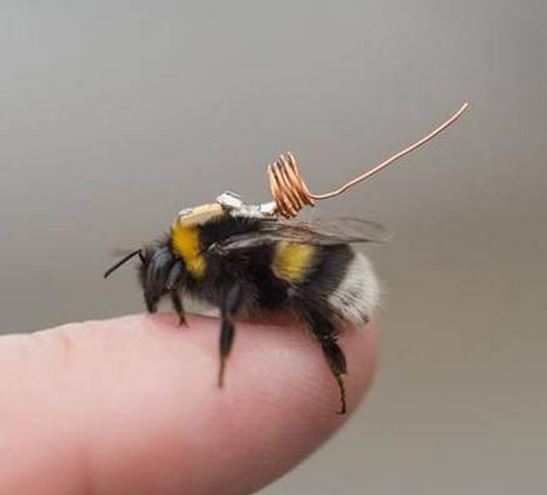In a study aimed at reversing bee decline, scientists at The Royal Botanic Gardens, Kew have glued tiny 4.8mm x 8mm microchips onto the insects’ backs so that they can monitor their movements in the landscape.
The New RFID (radio frequency identification) tags allow the tagged bees to be tracked up a distance of 1.2 metres from a detecting unit. The average range of a foraging bee is about 1 kilometre (0.6 of a mile) from its hive. So, if several detecting units can be placed within a 1 km radius, they will be able to monitor the bees’ behavoiur.
The new technology, once trialled, will help zoologists track bees between flower patches in the landscape, helping them more clearly identify the threats bee populations face, including the largely unknown impacts of pesticides and habitat fragmentation, as well as gaining valuable insight into the vital pollination services they provide.

With the RFID tags, scientists will be able to monitor the bees and hopefully gain insight into why their populations are declining. (Image: Kew)
Kew scientist Dr. Sarah Barlow trialled the new technology, developed by Tumbling Dice Ltd., on bumblebees in Kew’s Quarantine House.
Each RFID tag sends out a unique signal so that scientists can identify individual insects that are picked up by the detector unit.
The detectors send signals to readers which pass the data onto Raspberry Pi computers.
The technology could be used in the wild, with a network of detectors positioned within patches of flowers across the landscape to monitor the distances and paths of tagged bees.
Kew scientists used standard superglue to stick the RFID tags to the bees’ backs. The insects were chilled for about ten minutes to make them easier to handle, before the tags were placed with tweezers.
Dr. Barlow said:
“Although tracking technologies exist they are limited by size, range and reliability and until now, tags with mid to long range detection were too large to be carried by honeybees and worker bumblebees and have been used on larger insects and birds.”
“These tags are a big step forward in radio technology and no-one has a decent medium to long range tag yet that is suitable for flying on small insects. This new technology will open up possibilities for scientists to track bees in the landscape.”
“This piece of the puzzle, of bee behaviour, is absolutely vital if we are to understand better why our bees are struggling and how we can reverse their decline.”
The technology could also be used to monitor the movements of alien insect pests that can devastate native flora and fauna and cause considerable economic losses to farmers every year.
By understanding these pests’ lifestyles, scientists may have a better idea on how to control their populations and movements.
Kew wrote:
“These are just a few timely examples of how, with the use of the new technology, studying insect movement has wider reaching consequences for understanding the world around us.”
Many bees threatened with extinction
A study funded by the European Commission reported last week that 9.2% of Europe’s wild bee species are facing extinction. The researchers believe the insects’ demise is due to climate change and modern farming practices.
The number of flowers in Europe has declined considerably over recent decades.
Deputy Director of the IUCN Global Species Programme, Jean-Christophe Vié, said:
“This assessment is the best understanding we have had so far on wild bees in Europe. However, our knowledge about them is incomplete as we are faced with an alarming lack of expertise and resources. Bees play an essential role in the pollination of our crops.”
“We must urgently invest in further research in order to provide the best possible recommendations on how to reverse their decline.”
According to the Bumblebee Conservation Trust, the number of flowers in the British landscape has plummeted, leaving bees with a much reduced food supply.
Two species of bumblebees have become extinct in the UK over the past 75 years, while the outlook for many of the surviving ones does not look very promising.
Video – What would happen if all the bees died?
